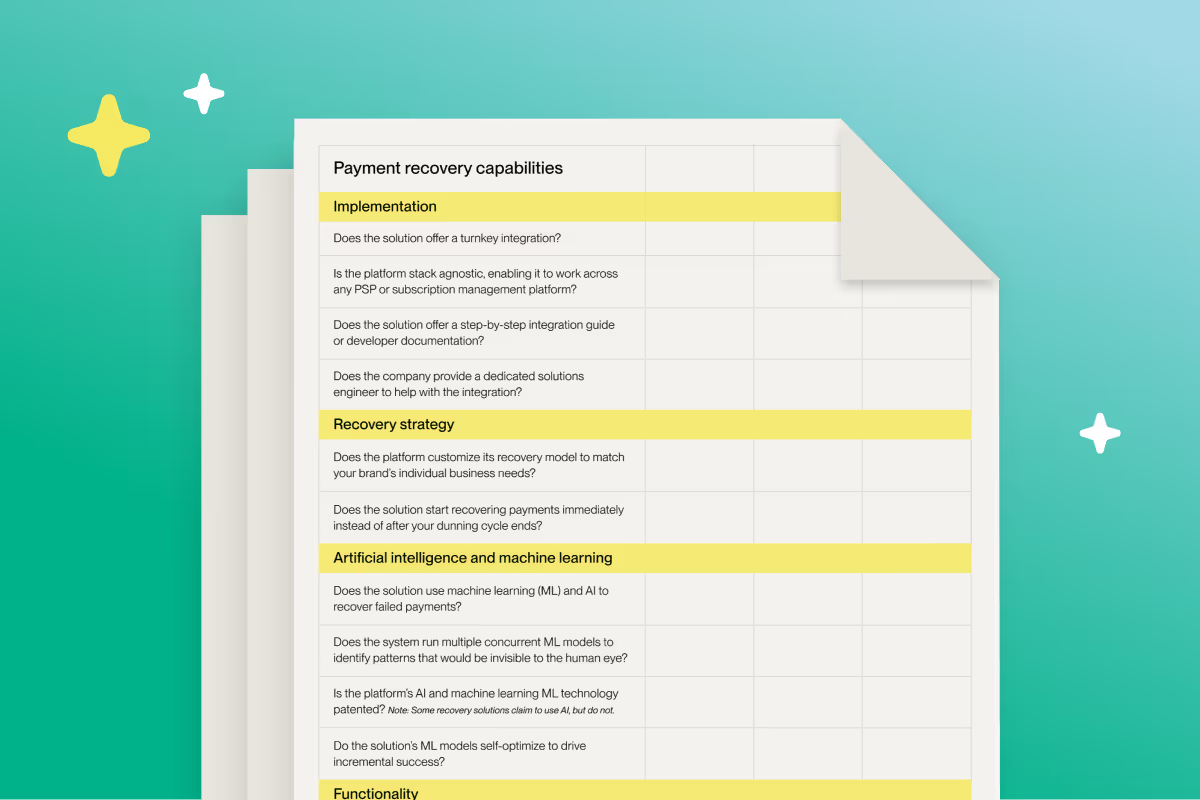
Stop involuntary churn: 3 proven fixes for pet brands
Enhance annual recurring revenue, reduce operational costs, and increase customer lifetime value with machine-learning-powered retries.
An acquisition-at-all-costs mindset is like a dog chasing its tail—inefficient and exhausting.
Over the last decade, customer acquisition costs (CAC) have increased by anywhere between 60% and 222%, depending on the source. As a result, merchants serving the pet industry have experienced decreased profitability and reduced growth.
The smarter, more sustainable path to success is focusing on customer retention.
When you keep existing pet parents happy and subscribed, you boost lifetime value, offset sky-high CAC, build lasting loyalty, and create a brand pets (and their humans) can count on for the long haul.
To help you create a more diverse and efficient growth plan, we’ve compiled everything you need to know about retention and strategies for keeping subscribers enrolled for longer.
Why retention is your most powerful growth lever
25-95%
profit increase from a 5% boost in retention
Retention-focused strategies are more cost-effective, efficient, and profitable than acquisition for 3 reasons.
Subscriber churn is a massive (but solvable) issue
Customer churn among pet-focused merchants is out of control. Approximately 39% of pet product subscribers churn within the first 3 months. This number jumps to 54% after 6 months.
These stats are eye-popping, but so is the next one. It’s estimated that failed payments cause 50% of customer churn, resulting in a 10% decrease in top-line revenue.
To put this in perspective, a merchant generating $30 million in annual recurring revenue could be losing $3 million each year to failed payments—an issue with a simple and effective solution.
It’s more efficient to sell to repeat customers
Selling to repeat subscribers is significantly easier than selling to new customers. This is because customers have already tested your product or service and are less risk-averse to trying new offerings.
Just as important, repeat customers purchase more on average than new customers. One study shows that repeat customers spend 67% more on average.
Retention has better ROI
Acquiring new customers requires substantial spending on advertising, promotions, and outreach, while retaining existing customers typically involves lower-cost efforts, such as email campaigns, loyalty programs, and customer service.
The ‘purrfect’ solution for subscriber retention
The most efficient and impactful strategy for boosting retention is to reduce involuntary churn caused by failed payments. Use these strategies to get started.
1. Retry payments at the right time
Timing is everything. Financial institutions closely monitor their customers' banking patterns. Attempting to retry a payment without considering the customer’s local time can appear suspicious and cause the transaction to be flagged for fraud.
For instance, imagine a video game company based in Seattle, Washington, that offers digital subscriptions to users worldwide and processes payments daily at 2 p.m.
While the payment timing makes sense for the video game company, it appears suspicious in regions with significantly different time zones. In this case, 2 p.m. in Seattle is 2:30 a.m. in parts of India.
In our hypothetical example, transactions initiated in India are more likely to fail because they are initiated in the middle of the night from a different country.
The solution is to run payments during business hours in your subscribers' local time zones.
2. Track your authorization rate by country
Tracking your authorization rate by country enables you to identify and address payment issues that may not be apparent otherwise. For example, Butter has worked with several businesses that believed they had a transaction issue affecting an entire region (e.g., Europe and South America), when in fact, the problem was with a single bank in one country.
3. Utilize dynamic retries
When a payment fails, you may be tempted to retry the transaction until it is successful—don’t.
Repeatedly retrying failed transactions is known as “woodpeckering.” This approach has a low likelihood of success and can negatively impact your authorization rate. Worse still, payments recovered through this method are more likely to be disputed.
Athena Club, a personal care brand, used a woodpecker methodology in an attempt to reduce failed payments. The brand retried payments 6 times every 6 days.
“Retrying six times every six days was okay, but not great,” said Alexander Sokolov, Senior Director of Software Engineering at Athena Club. “It was mostly just random luck when a payment went through.”
A more effective approach is to utilize dynamic retries. This involves analyzing transaction data to determine the best approach for resolving each category of failed payments. Armed with this data, you can then retry failed payments in real time.
A successful dynamic retry strategy requires advanced machine-learning techniques to parse millions of individual pieces of data. While it’s possible to build your retry solution, most merchants partner with a dedicated third-party solution like Butter.
Maximize recurring revenue with Butter
Powered by advanced machine learning technology, Butter analyzes payment data to identify recurring payment issues and then resolves them automatically, eliminating the need for subscribers to update their card information or cancel recurring orders. Leading brands like The Athletic, MasterClass, Fabletics, and Athena Club utilize Butter to retain subscribers, extend LTV, and drive profit.
How The Athletic hit a home run and recovered millions in revenue

figures in recovered revenue since 2023
lift in revenue recovery rate
decrease in payment processing fees
About The Athletic
The Athletic, founded in 2016 and acquired by The New York Times in 2022, operates the world’s largest sports newsroom with over 500 full-time employees covering more than 250 professional sports and collegiate teams in the U.S. and globally. The sports news site offers a monthly subscription that brings fans closer to the sports they love.
Opportunity
The Athletic, one of the fastest-growing sports media brands in the world, partnered with a legacy failed payment solution to reduce involuntary churn and increase retention. The solution used the same recovery strategy for every failed payment category, including instances of fraud. To reach their growth goals, The Athletic required a more advanced and nuanced solution.
Solution
The Athletic tapped Butter to power their payment recovery. What set the Butter apart was the solution’s data-driven approach and machine learning capabilities. Butter’s solution self-optimizes over time, increasing the effectiveness of The Athletic’s retry strategy while simultaneously freeing resources to focus on other revenue activities and core competencies.
See The Athletic expanded case study for the whole story
Dr. Squatch boosts monthly recovered revenue by 11% with Butter in 5 months.

Increase in monthly recovered revenue
Invoice recovery rate
(vs. industry avg. of 15% for DTC brands)
Boost in authorization rate
About Dr. Squatch
Dr. Squatch is a natural men's soap and personal care company that has grown its sales 15x over the last five years. Subscriptions, which make up a third of the company's total direct-to-consumer business, play a significant role in this growth.
The Challenge
When Dr. Squatch identified that 25% of their overall churn was due to failed payments, they embarked on a mission to address the issue. However, they discovered that solving the challenge required extensive payment expertise.
Why? Every transaction is associated with 128 pieces of data and more than 2,000 error codes, making it nearly impossible to determine the actual cause of a failed transaction without a dedicated payment recovery solution.
The Solution
Dr. Squatch thoroughly evaluated various solutions, assessing factors such as use, effectiveness, and cost. After careful consideration, they selected Butter in part because of the platform’s machine-learning-based capabilities.
Unlike other solutions, Butter’s ML technology doesn't just retry failed payments. It analyzes hundreds of data points associated with each transaction and uses this information to determine the most effective retry strategy for each payment. This unique approach drives optimal recovery at reduced costs and significantly increases payment success and recovery rates.






